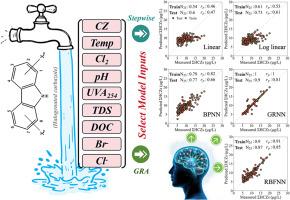Novel insights into halogenated carbazoles (HCZs) prediction in tap water: a comparative study of grey relational analysis-based neural networks
IF 10
1区 环境科学与生态学
Q1 ENGINEERING, ENVIRONMENTAL
引用次数: 0
Abstract
In recent years, halogenated carbazoles (HCZs) have emerged as a novel class of disinfection byproducts (DBPs) detected in tap water, posing potential dioxin-like toxicity risk to human health. Therefore, it is particularly important to detect HCZs in tap water, yet this process is time-consuming and labor-intensive. To address this challenge, developing predictive models for HCZs based on water quality parameters presents an attractive alternative. Unfortunately, no prediction studies for HCZs have been reported to date. This study investigated the feasibility of using linear models, log-linear models, backpropagation neural networks (BPNN), general regression neural networks (GRNN), and radial basis function neural networks (RBFNN) to predict the occurrence of HCZs, including 3-chlorocarbazole (3-CCZ), 3-bromocarbazole (3-BCZ) and total halogenated carbazoles (ΣHCZs) in tap water. The input parameters for BPNN, GRNN, and RBFNN were selected based on grey relational analysis (GRA) results, while the linear and log-linear models were developed using stepwise regression. The results showed that linear and log-linear models were not suitable (N25=0.30-0.64, rp=0.40-0.71), and BPNN demonstrated limited prediction performance (N25=0.52-0.78, rp=0.77-0.83). GRNN excelled only in predicting ΣHCZs (N25=0.98, rp=0.96). Particularly, RBFNN exhibited good performance in predicting 3-CCZ, 3-BCZ, and ΣHCZs (N25=0.70-0.89, rp=0.89-0.94), providing valuable insights and possibilities for real-time monitoring of HCZs in tap water.

自来水中卤代咔唑(HCZ)预测的新见解:基于灰色关系分析的神经网络比较研究
近年来,卤代咔唑(hcz)作为自来水中检测到的一类新型消毒副产物(DBPs)出现,对人类健康构成潜在的二恶英样毒性风险。因此,检测自来水中的hccs尤为重要,但这一过程耗时耗力。为了应对这一挑战,开发基于水质参数的hcz预测模型是一个有吸引力的选择。不幸的是,迄今为止还没有关于hccs的预测研究报告。本研究探讨了采用线性模型、对数线性模型、反向传播神经网络(BPNN)、广义回归神经网络(GRNN)和径向基函数神经网络(RBFNN)预测自来水中3-氯咔唑(3-CCZ)、3-溴咔唑(3-BCZ)和总卤代咔唑(ΣHCZs)等hccs发生的可行性。基于灰色关联分析(GRA)结果选择BPNN、GRNN和RBFNN的输入参数,采用逐步回归方法建立线性和对数线性模型。结果表明,线性和对数线性模型均不适用(N25=0.30-0.64, rp=0.40-0.71), BPNN的预测效果有限(N25=0.52-0.78, rp=0.77-0.83)。GRNN仅在预测ΣHCZs方面表现较好(N25=0.98, rp=0.96)。特别是RBFNN在预测3-CCZ、3-BCZ和ΣHCZs方面表现良好(N25=0.70-0.89, rp=0.89-0.94),为自来水中hccs的实时监测提供了有价值的见解和可能性。
本文章由计算机程序翻译,如有差异,请以英文原文为准。
求助全文
约1分钟内获得全文
求助全文
来源期刊

Journal of Cleaner Production
环境科学-工程:环境
CiteScore
20.40
自引率
9.00%
发文量
4720
审稿时长
111 days
期刊介绍:
The Journal of Cleaner Production is an international, transdisciplinary journal that addresses and discusses theoretical and practical Cleaner Production, Environmental, and Sustainability issues. It aims to help societies become more sustainable by focusing on the concept of 'Cleaner Production', which aims at preventing waste production and increasing efficiencies in energy, water, resources, and human capital use. The journal serves as a platform for corporations, governments, education institutions, regions, and societies to engage in discussions and research related to Cleaner Production, environmental, and sustainability practices.
 求助内容:
求助内容: 应助结果提醒方式:
应助结果提醒方式:


